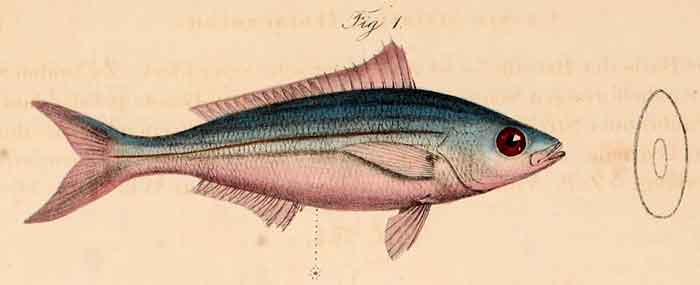Superregnum: Eukaryota
Regnum: Animalia
Subregnum: Eumetazoa
Cladus: Bilateria
Cladus: Nephrozoa
Superphylum: Deuterostomia
Phylum: Chordata
Cladus: Craniata
Subphylum: Vertebrata
Infraphylum: Gnathostomata
Megaclassis: Osteichthyes
Superclassis/Classis: Actinopterygii
Classis/Subclassis: Actinopteri
Subclassis/Infraclassis: Neopterygii
Infraclassis: Teleostei
Megacohors: Osteoglossocephalai
Supercohors: Clupeocephala
Cohors: Euteleosteomorpha
Subcohors: Neoteleostei
Infracohors: Eurypterygia
Sectio: Ctenosquamata
Subsectio: Acanthomorphata
Divisio/Superordo: Acanthopterygii
Subdivisio: Percomorphaceae
Series: Eupercaria
Ordo: Perciformes
Subordo: Percoidei
Superfamilia: Percoidea
Familia: Caesionidae
Genus: Caesio
Species: C. caerulaurea – C. cuning – C. lunaris – C. striata – C. suevica – C. teres – C. varilineata – C. xanthalytos – C. xanthonota
Name
Caesio Lacepède, 1801

Caesio striata
References
Holleman, W.; Connell, A.D.; Carpenter, K.E. 2013: Caesio xanthalytos, a new species of fusilier (Perciformes: Caesionidae) from the Western Indian Ocean, with records of range extensions for several species of Caesionidae. Zootaxa 3702(3): 262–272. DOI: 10.11646/zootaxa.3702.3.4 Reference page.
Links
Caesio – Taxon details on Integrated Taxonomic Information System (ITIS).
Caesio species list in FishBase,
Froese, R. & Pauly, D. (eds.) 2021. FishBase. World Wide Web electronic publication, www.fishbase.org, version 02/2021.
Vernacular names
English: Fusiliers
Caesio is a genus of marine ray-finned fish, fuiliers elonging to the family Caesionidae. They are native to the Indian Ocean and the western Pacific Ocean, although one species has invaded the eastern Mediterranean Sea through the Suez Canal by Lessepsian migration.
Taxonomy
Caesio was created in 1801 by the French naturalist Bernard Germain de Lacépède when he described Caesio caerilaurea. In 1876 the Dutch ichthyologist Pieter Bleeker designated C. caerulaurea as the type species of the genus Caesio.[1] The genus name, Caesio, means ”blue”.[2]
Species
Currently, 9 species in this genus are recognized,[3][4] organised into three subgenera according to some authorities:[2]
Subgenus Caesio
Caesio caerulaurea Lacépède, 1801 – blue and gold fusilier
Caesio striata Rüppell, 1830 – striated fusilier
Caesio varilineata K. E. Carpenter, 1987 – variable-lined fusilier
Caesio xanthalytos Holleman, Connell & K. E. Carpenter, 2013[4]
Subgenus Flavicaesio
Caesio suevica Klunzinger, 1884 – Suez fusilier
Caesio teres Seale, 1906 – yellow and blueback fusilier
Caesio xanthonota Bleeker, 1853 – yellowback fusilier
Subgenus Odontonectes
Caesio cuning (Bloch, 1791) – redbelly yellowtail fusilier
Caesio lunaris G. Cuvier, 1830 – lunar fusilier
Characteristics
Caesio fusiliers have a reasonably high, fusiform and elongate body which is moderately laterally compressed. They have a continuous dorsal fin which has 10 spines, all of which are connected by membranes and have 13-16 soft rays. The anal fin has 3 spines and 10-13 soft rays. Both these fins have scales. The pectoral fins have 17 -23 rays. They may be plain or have one or more horizontal stripes and there may be black markings on the tail, typically black spots on the tips of the lobes or black lines in the middle of lobes.[5]
Distribution and habitat
Caesio fusiliers are found in coastal areas of the Indian and Pacific Oceans, including the Red Sea.[5] One species, C. varilineata has been recorded in the eastern Mediterranean, probably having reached there through the Suez Canal as a Lessepsian migrant.[6] They are mainly found on coral reefs.[5]
Biology
Caesio fusiliers are sociable Fishes which aggregate in schools, frequently forming mixed species schools with other fusilier species. These fish have a diet dominated by zooplankton from midwater while in their schools. They attain sexual maturity quickly and the females have high fecundity. They lay numerous small, pelagic eggs and spawning occurs throughout much of the year. Spawning aggregations form at periods determined by lunar cycles.[5]
Fisheries
Caesio fusiliers are of some importance to inshore fisheries. They are taken using drive-in nets, gili nets, traps, trawls, and handlines. The catch is sold as fresh fish or preserved as salted fish. The juveniles of some species are caught to be used as bait in tuna fisheries.[5]
References
Eschmeyer, William N.; Fricke, Ron & van der Laan, Richard (eds.). "Genera in the family Lutjanidae". Catalog of Fishes. California Academy of Sciences. Retrieved 2 July 2021.
Christopher Scharpf & Kenneth J. Lazara, eds. (5 January 2021). "Order LUTJANIFORMES: Families HAEMULIDAE and LUTJANIDAE". The ETYFish Project Fish Name Etymology Database. Christopher Scharpf and Kenneth J. Lazara. Retrieved 3 July 2021.
Froese, Rainer and Pauly, Daniel, eds. (2013). Species of Caesio in FishBase. June 2013 version.
Holleman, W.; Connell, A.D. & Carpenter, K.E. (2013). "Caesio xanthalytos, a new species of fusilier (Perciformes: Caesionidae) from the Western Indian Ocean, with records of range extensions for several species of Caesionidae". Zootaxa. 3702 (3): 262–272. doi:10.11646/zootaxa.3702.3.4.
Kent E. Carpenter (1988). FAO Species Catalogue Volume 8 Fusilier Fishes of the World (PDF). FAO Rome. p. 35.
Bos A.R. & J. Ogwang (2018). "Caesio varilineata Carpenter, 1987 (Osteichthyes: Caesionidae) a new alien fish in the southeastern Mediterranean Sea" (PDF). BioInvasions Records. 7 (4): 441–445. doi:10.3391/bir.2018.7.4.15.
Retrieved from "http://en.wikipedia.org/"
All text is available under the terms of the GNU Free Documentation License

